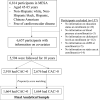Heterogeneity in the Association Between the Presence of Coronary Artery Calcium and Cardiovascular Events: A Machine-Learning Approach in the MESA Study
- PMID: 36314118
- PMCID: PMC9812415
- DOI: 10.1161/CIRCULATIONAHA.122.062626
Heterogeneity in the Association Between the Presence of Coronary Artery Calcium and Cardiovascular Events: A Machine-Learning Approach in the MESA Study
Abstract
Background: Coronary artery calcium (CAC) has been widely recognized as an important predictor of cardiovascular disease (CVD). Given the finite resources, it is important to identify individuals who would receive the most benefit from detecting positive CAC by screening. However, the evidence is limited as to whether the burden of positive CAC on CVD differs by multidimensional individual characteristics. We sought to investigate the heterogeneity in the association between positive CAC and incident CVD.
Methods: This cohort study included adults from MESA (Multi-Ethnic Study of Atherosclerosis) ages ≥45 years and free of cardiovascular disease. After propensity score matching in a 1:1 ratio, we applied a machine learning causal forest model to (1) evaluate the heterogeneity in the association between positive CAC and incident CVD, and (2) predict the increase in CVD risk at 10-years when CAC>0 (versus CAC=0) at the individual level. We then compared the estimated increase in CVD risk when CAC>0 to the absolute 10-year atherosclerotic CVD (ASCVD) risk calculated by the 2013 American College of Cardiology/American Heart Association pooled cohort equations.
Results: Across 3328 adults in our propensity score-matched analysis, our causal forest model showed the heterogeneity in the association between CAC>0 and incident CVD. We found a dose-response relationship of the estimated increase in CVD risk when CAC>0 with higher 10-year ASCVD risk. Almost all individuals (2293 of 2428 [94.4%]) with borderline risk of ASCVD or higher showed ≥2.5% increase in CVD risk when CAC>0. Even among 900 adults with low ASCVD risk, 689 (69.2%) showed ≥2.5% increase in CVD risk when CAC>0; these individuals were more likely to be male, Hispanic, and have unfavorable CVD risk factors than others.
Conclusions: The expected increases in CVD risk when CAC>0 were heterogeneous across individuals. Moreover, nearly 70% of people with low ASCVD risk showed a large increase in CVD risk when CAC>0, highlighting the need for CAC screening among such low-risk individuals. Future studies are needed to assess whether targeting individuals for CAC measurements based on not only the absolute ASCVD risk but also the expected increase in CVD risk when CAC>0 improves cardiovascular outcomes.
Keywords: atherosclerosis; cardiovascular disease; machine learning; precision medicine; propensity score.
Figures



References
-
- Nasir K, Cainzos-Achirica M. Role of coronary artery calcium score in the primary prevention of cardiovascular disease. BMJ. 2021;373:n776. doi: 10.1136/bmj.n776 - PubMed
-
- Greenland P, LaBree L, Azen SP, Doherty TM, Detrano RC. Coronary artery calcium score combined with Framingham score for risk prediction in asymptomatic individuals. JAMA. 2004;291:210–215. doi: 10.1001/jama.291.2.210 - PubMed
-
- Taylor AJ, Bindeman J, Feuerstein I, Cao F, Brazaitis M, O’Malley PG. Coronary calcium independently predicts incident premature coronary heart disease over measured cardiovascular risk factors: mean three-year outcomes in the Prospective Army Coronary Calcium (PACC) project. J Am Coll Cardiol. 2005;46:807–814. doi: 10.1016/j.jacc.2005.05.049 - PubMed
-
- Budoff MJ, Shaw LJ, Liu ST, Weinstein SR, Mosler TP, Tseng PH, Flores FR, Callister TQ, Raggi P, Berman DS. Long-term prognosis associated with coronary calcification: observations from a registry of 25,253 patients. J Am Coll Cardiol. 2007;49:1860–1870. doi: 10.1016/j.jacc.2006.10.079 - PubMed
-
- Detrano R, Guerci AD, Carr JJ, Bild DE, Burke G, Folsom AR, Liu K, Shea S, Szklo M, Bluemke DA, et al. Coronary calcium as a predictor of coronary events in four racial or ethnic groups. N Engl J Med. 2008;358:1336–1345. doi: 10.1056/NEJMoa072100 - PubMed

